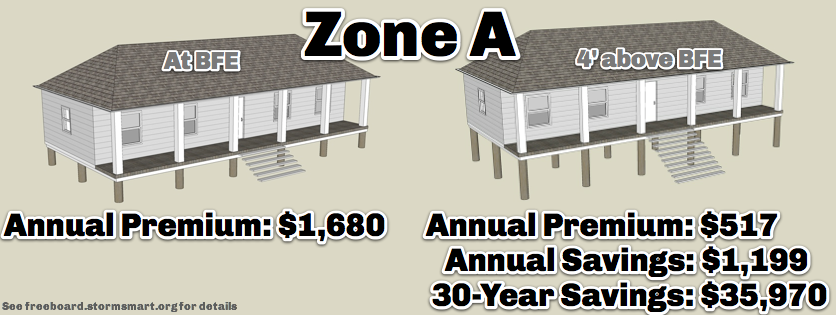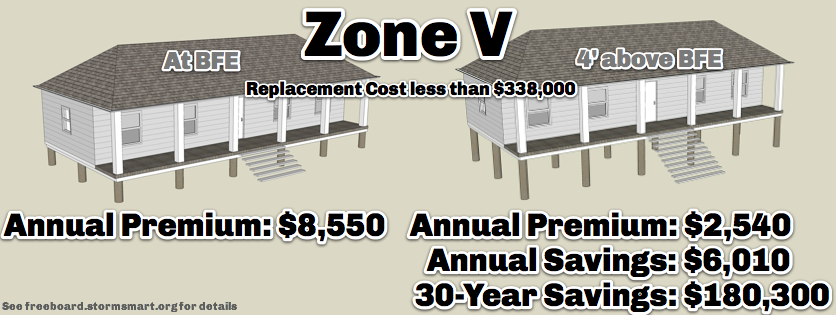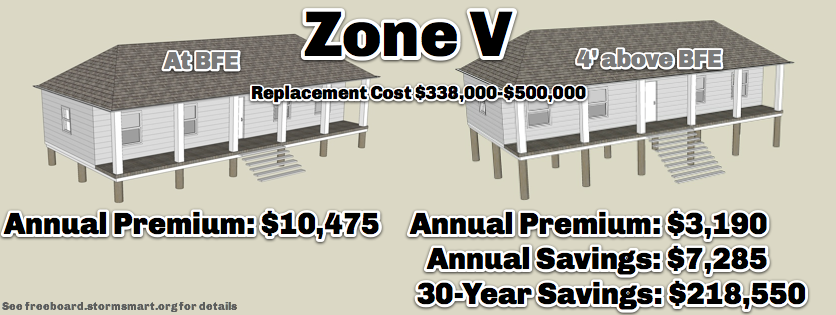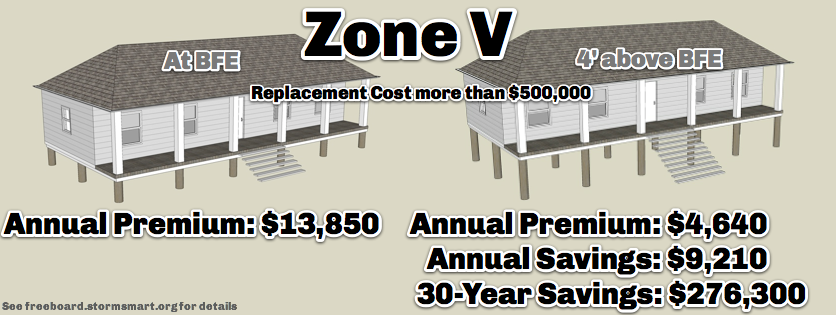As we pointed out, the best reason to build higher is to avoid the loss and misery that goes with being flooded. But there are HUGE financial incentives, too: The National Flood Insurance Program generously rewards those who build higher than the program requires. The savings apply both to those who elect to do it on their own and those who are required to do it because of state or local regulations.
Determining flood insurance rates can be complex and is very dependent on a specific structure’s characteristics, but for illustrative purposes we’ve crunched the numbers for a hypothetical, one-story structure with maximum coverage ($250,000 for the structure, $100,000 for contents) and standard deductible.1
Choose a flood zone below to get an idea of how much money building higher can save (and how much not building higher can cost you). Elevations below are given relative to the Base Flood Elevation (BFE), which is the minimum height required by the NFIP.2
↑ ↑ Select a flood zone above for an example of possible savings. ↑ ↑

For more information on flood zones, see FEMA’s site. The short version is that Zone V areas are subject to waves of three feet or higher during a storm that has a 1% chance of occurring any year. Zone A areas have waves lower than three feet tall during that same event.
Zone A

| Annual Savings | 30-Year Savings | |
|---|---|---|
| 4′ Above BFE | $1,199 (71%) | $35,970 |
| 3′ Above BFE | $1,163 (69%) | $34,890 |
| 2′ Above BFE | $1,091 (65%) | $32,730 |
| 1′ Above BFE | $842 (50%) | $25,245 |
| At BFE | n/a | n/a |
| 1′ BELOW BFE | -$3,916 (-233%) | -$117,465 |
Zone V
In Zone V, the replacement cost of the building is factored into the insurance rating. The replacement cost is the amount of money required to replace or repair the insured building in the event of loss or damage, without a deduction for depreciation. See the FEMA rate tables for more details.
Replacement Cost Less Than $338,000

| Annual Savings | 30-Year Savings | |
|---|---|---|
| 4′ Above BFE | $6,010 (70%) | $180,300 |
| 3′ Above BFE | $5,680 (66%) | $170,400 |
| 2′ Above BFE | $4,555 (53%) | $136,650 |
| 1′ Above BFE | $2,685 (31%) | $80,550 |
| At BFE | n/a | n/a |
| 1′ BELOW BFE | -$2,980 (-35%) | -$89,400 |
| 2′ BELOW BFE | -$7,140 (-84%) | -$214,200 |
| 3′ BELOW BFE | -$10,220 (-119%) | -$306,600 |
Replacement Cost $338,000-$500,000

| Annual Savings | 30-Year Savings | |
|---|---|---|
| 4′ Above BFE | $7,285 (70%) | $218,550 |
| 3′ Above BFE | $6,755 (65%) | $202,650 |
| 2′ Above BFE | $5,405 (52%) | $162,150 |
| 1′ Above BFE | $3,035 (29%) | $91,050 |
| At BFE | n/a | n/a |
| 1′ BELOW BFE | -$3,655 (-35%) | -$109,650 |
| 2′ BELOW BFE | -$ 8,665 (-83%) | -$259,950 |
| 3′ BELOW BFE | -$ 12,045 (-115%) | -$361,350 |
Replacement Cost More Than $500,000

| Annual Savings | 30-Year Savings | |
|---|---|---|
| 4′ Above BFE | $9,210 (67%) | $276,300 |
| 3′ Above BFE | $8,530 (62%) | $255,900 |
| 2′ Above BFE | $6,580 (48%) | $197,400 |
| 1′ Above BFE | $3,935 (28%) | $118,050 |
| At BFE | n/a | n/a |
| 1′ BELOW BFE | -$4,655 (-34%) | -$139,650 |
| 2′ BELOW BFE | -$10,790 (-78%) | -$323,700 |
| 3′ BELOW BFE | -$14,120 (-102%) | -$423,600 |
-
Calculations are based on the
January 2013 Flood Insurance Manual, for the structure described above elevated without enclosures. Post-FIRM, primary residence. We’ve done our best to verify these numbers (including running them by some folks at FEMA), but we’re not insurance salespeople — go see one of them if you need precise figures for your building. Also note that these numbers do NOT reflect higher premiums expected to come for many properties as a result of the Biggert-Waters Flood Insurance Reform Act. - The base flood is the 1%-annual-chance flood, commonly called the “hundred year flood.” Base Flood Elevation is the water-surface elevation of the base flood. The depth of the base flood can be calculated by subtracting the ground elevation from the BFE. The probability is 1% that rising water will reach BFE height in any year, which compounds over a thirty-year period to 26% or more.The best reason to build higher is to avoid the loss and misery that goes with being flooded. But there are HUGE financial incentives, too: The National Flood Insurance Program generously rewards those who build higher than the program requires. The savings apply both to those who elect to do it on their own and those who are required to do it because of state or local regulations.